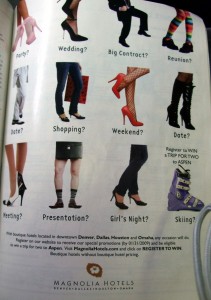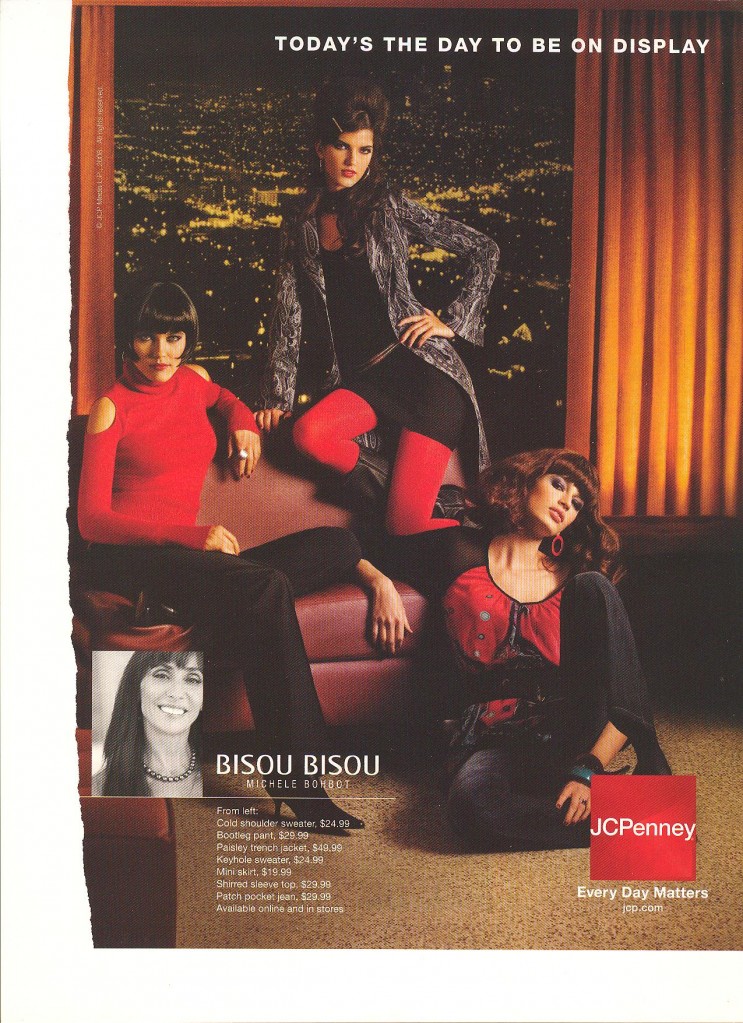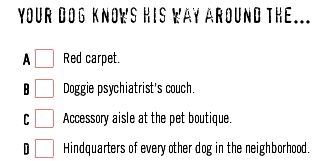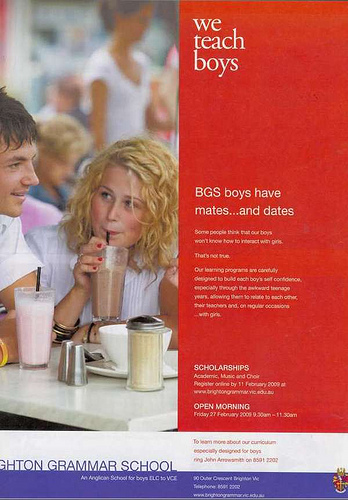Bri A. sent sent in photos of two ads found in complimentary magazines provided on a recent flight she took (she doesn’t remember the names of the magazines). Both have some interesting gender aspects.
The first is for Magnolia Hotels:

Notice the suggested reasons women might be visiting the hotel: party, wedding, reunion, shopping, weekend, date, meeting, girl’s night, skiing (maybe? They’re light purple…). For men: big contract, date, presentation. Bri says,
The only professional woman presented to us in the ad is a woman who is going to a “meeting”. The woman’s shoes however, are a little racy for business and unlike her male colleagues, one of which is doing some sort of jig and the other which has forgotten his pants, she is giving us a little flirty heel raise rather than being humorous or professional. Another interesting difference that stuck out to me was the attire of the man and woman going on a date. The man going on a date is wearing a nice white suit, while the woman is wearing a much less formal and good deal more provocative outfit.
Actually, almost all the female feet are doing flirty little heel raises or half-kicks or something, which somehow doesn’t have quite the same effect as the kick the “big contract” guy is doing.
From another complimentary magazine Bri found on the same trip, an ad for Selective Search, a dating service for the business class:

The company technically serves men and women. But notice that the image only depicts women, and in the second paragraph we learn that “we hand select the must-meet women for our clients.” Close-ups of the lists for “selectively single” men and women:


Notice the men are described as “clientele,” while the women are described as “candidates.” Here are two screenshots from the website, the first from the women’s section, the second from the men’s section:

![]()
So ladies, they’ll find you a guy who is commitment-minded, but there aren’t many other specifics–he’ll be a quality, eligible guy, but that could mean a lot of things. Guys get some more specifics–she’ll be attractive and desirable. Somehow a “guy who brings just as much to the table as you do” doesn’t sound quite the same to me as a woman “who meets your exacting standards and criteria.” Bringing as much to the table as you do implies equality. But having exacting standards that must be met doesn’t imply anything about equality–you can have standards for other people even though you couldn’t meet most of them yourself.
Aside from the specifics of the two images themselves, you might talk about the seeming assumption that though the dating service caters to both male and female customers, the people most likely to be reading an ad placed in a business magazine on an airline will be male, and thus the ad should target a male audience (by having images only of women and stressing meeting women in the text). The presumption is either that business people who fly aren’t women, or that women remember to bring their own reading material so they aren’t stuck reading the complimentary magazines the airlines provide.
Thanks, Bri!
UPDATE: In a comment, OP Minded says,
My brother has been in the dating service industry for about 10 years and he tells me that their internal research on this stuff is compelling and very very clear. In searching for a date on a dating service:
95% of women care most about 1) Educational level, and 2) Income.
95% of men care most about 1) Looks, and 2) Weight.Other issues come in to play later in the process, but at the beginning, this is what most of the folks are looking for.
In another comment, Sandra points out,
…I do remember being taught in my undergrad speech department classes that, for instance, in studies on gender effects, when asked to fill out surveys on the street by either a male or a female, women are more likely to respond to the women poll-takers, but the men are also more likely to respond to the women poll-takers [than] men [poll-takers]. So perhaps the marketing move behind the photograph in this dating service ad was based on the idea that, women appeal to women, and women appeal to men. Hence, the women in the image. It could be the women are intended to see themselves in the photos, as people using this service, and men are intended to see the women as possible dates.
Good point, Sandra!







